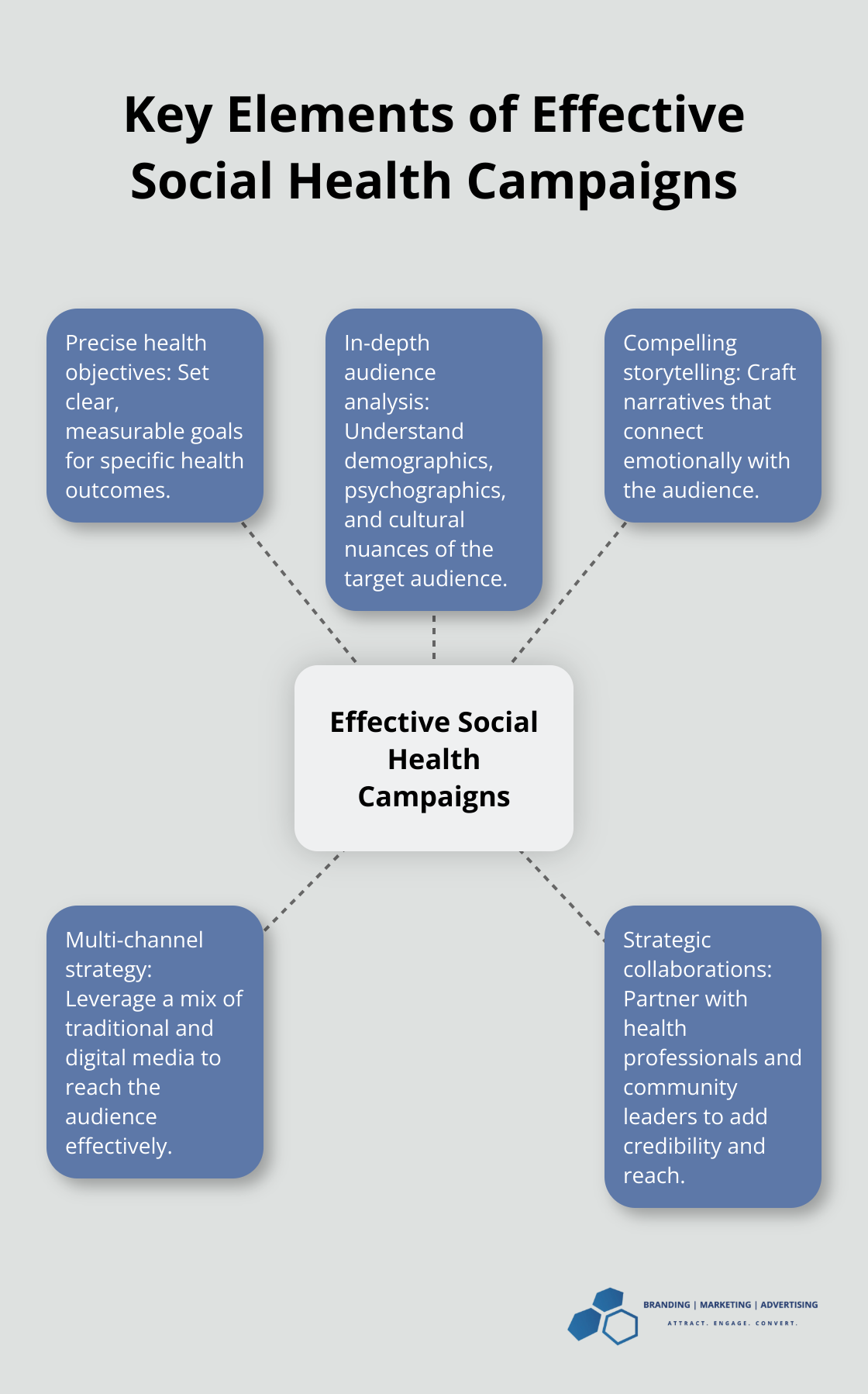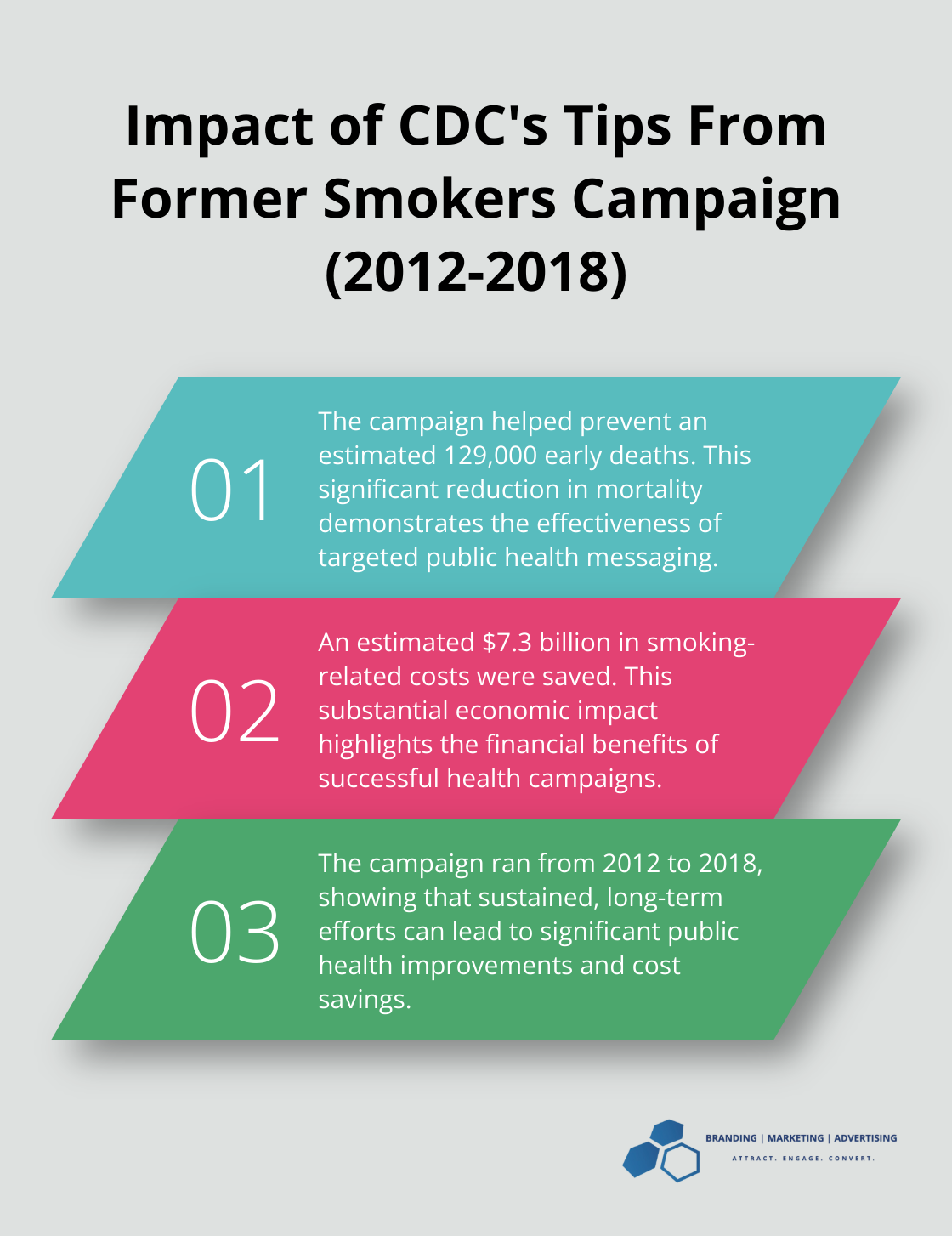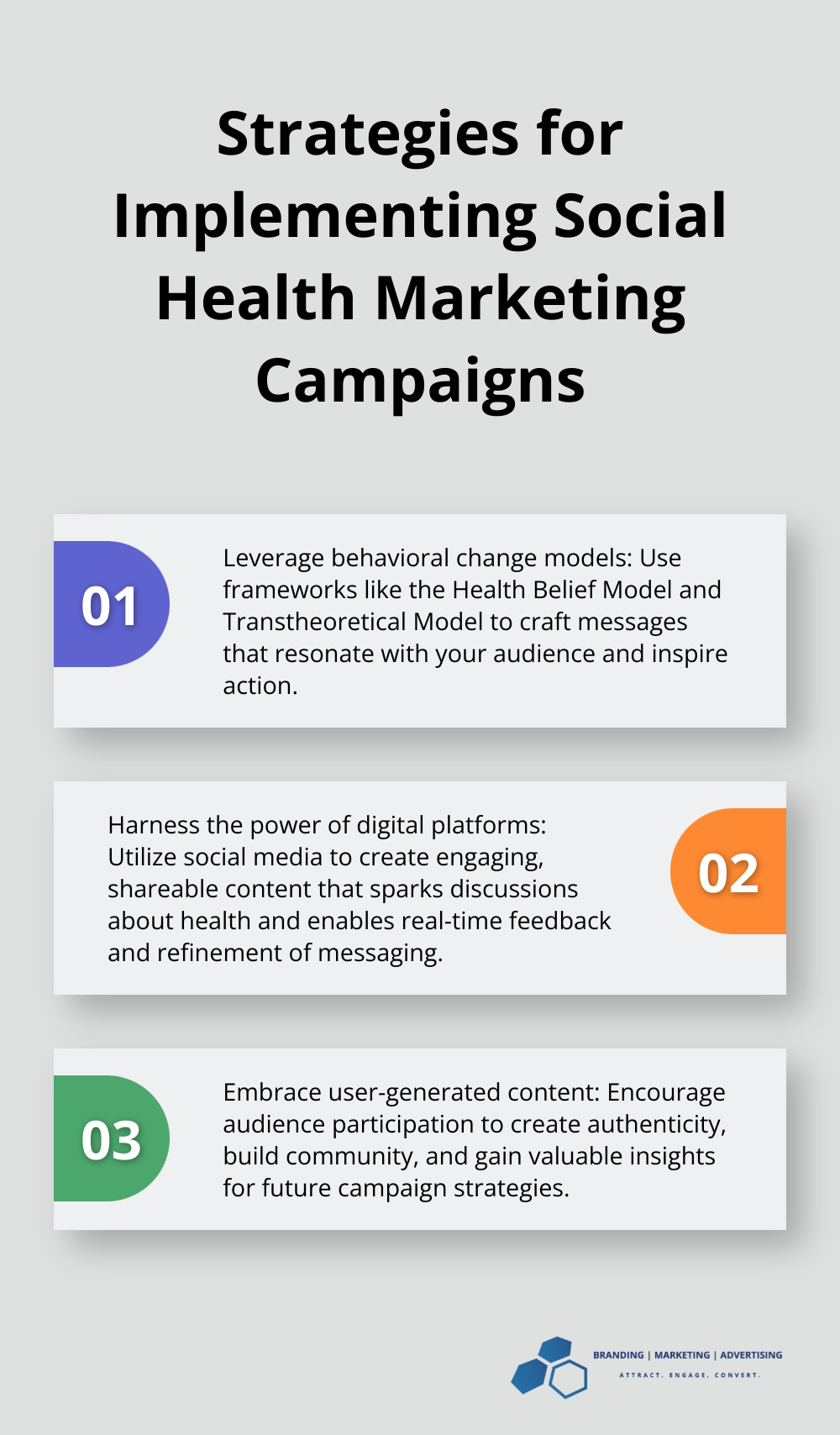How to Create Effective Social Health Marketing Campaigns
At Branding | Marketing | Advertising, we’ve seen the power of social marketing health campaigns to drive positive change. These initiatives blend public health goals with marketing strategies to promote healthier behaviors.
Our blog post explores how to create effective campaigns that resonate with audiences and make a real impact. We’ll cover key elements, best practices, and measurement techniques to help you craft successful social health marketing initiatives.
What Is Social Health Marketing?
Health communication is related to social marketing, which involves the development of activities and interventions designed to positively change behaviors. This powerful approach transforms communities and improves health outcomes.
The Core of Social Health Marketing
Social health marketing influences public behaviors for the greater good. Unlike traditional marketing that sells products, social health marketing promotes ideas, attitudes, and lifestyle changes. Campaigns might encourage people to quit smoking, get vaccinated, or adopt healthier eating habits.
Tailoring Messages for Maximum Impact
Social health campaigns often target specific demographics or at-risk populations. This focus on audience segmentation sets them apart from traditional marketing. For example, a campaign about teen pregnancy prevention uses very different messaging and channels than one promoting mammograms for women over 50.
Measuring Success Beyond Sales
Traditional marketing measures success in sales and profits. Social health marketing, however, looks at public health outcomes. Success might include increased vaccination rates, reduced STD transmission, or improved mental health awareness.
Collaboration is Key
Social health marketing often involves partnerships between health organizations, government agencies, and community groups. This collaborative approach ensures messages are credible, culturally appropriate, and widely disseminated.
Long-Term Vision for Public Health
Social health marketing requires sustained efforts over months or years to create lasting behavioral changes. This long-term approach addresses complex public health issues like obesity or mental health stigma.
Understanding these unique aspects of social health marketing allows organizations to create more effective campaigns that truly make a difference in public health. The next section will explore the key elements that make these campaigns successful.
What Makes Social Health Campaigns Effective?
Social health marketing campaigns require specific elements to drive meaningful change. At Branding | Marketing | Advertising, we’ve identified key components that contribute to successful initiatives.

Precise Health Objectives
Effective campaigns start with clear, measurable goals. Instead of broad aims like “improve public health,” successful initiatives target specific outcomes. A campaign might aim to increase HPV vaccination rates among children ages 9-12. This precision allows for better strategy development and easier evaluation of success.
In-Depth Audience Analysis
Knowing your audience thoroughly is essential. This extends beyond basic demographics to include psychographics, behavior patterns, and cultural nuances. A campaign targeting new mothers about postpartum depression would consider factors like sleep deprivation, hormonal changes, and societal pressures. This deep understanding shapes messaging that truly resonates.
Compelling Storytelling
Facts alone don’t change behavior; compelling narratives do. We craft stories that connect emotionally with the target audience. These stories often feature relatable characters overcoming obstacles similar to those faced by the audience. The CDC’s Tips From Former Smokers campaign exemplifies this approach, using real people’s experiences to illustrate the dangers of smoking. During 2012–2018, this campaign helped prevent an estimated 129,000 early deaths and helped save an estimated $7.3 billion in smoking-related costs.

Multi-Channel Strategy
No single communication channel reaches everyone. Successful campaigns leverage a mix of traditional and digital media. This might include TV spots, social media content, community events, and partnerships with healthcare providers. The key is to meet the audience where they are (whether that’s scrolling Instagram or watching local news).
Strategic Collaborations
Health professionals and community leaders add credibility and reach to campaigns. We partner with respected figures who can amplify messages and provide expert insights. This might involve working with pediatricians for a childhood obesity prevention campaign or collaborating with religious leaders for an initiative on mental health in faith communities.
These elements work together to create <a href=”https://bestbma.com/how-to-create-effective-health-advertising-campaigns/”>social health marketing campaigns</a> that drive real change. They transform complex health information into actionable messages that motivate behavior change. The next section will explore best practices for implementing these campaigns effectively, ensuring maximum impact and reach.
<a href=”https://bestbma.com/how-to-use-social-marketing-for-public-health-success/”>Social marketing for public health</a> requires a strategic approach. Our next chapter will outline key implementation strategies to maximize the effectiveness of your campaigns.
Implementing Effective Social Health Marketing Campaigns
Social health marketing campaigns require a strategic approach to drive meaningful change. This chapter explores key implementation strategies to maximize the effectiveness of your campaigns.

Leverage Behavioral Change Models
Effective campaigns inspire action, not just inform. The Health Belief Model focuses on perceived susceptibility, severity, benefits, and barriers to health behaviors. This framework helps craft messages that resonate. For example, a campaign to increase colorectal cancer screenings might emphasize both the risks of undetected cancer and the ease of modern screening methods.
The Transtheoretical Model recognizes that behavior change happens in stages. Messages should meet people where they are. For someone just considering quitting smoking, the focus might be on building awareness of health risks. For those ready to quit, the campaign provides actionable steps and resources.
Harness the Power of Digital Platforms
Social media isn’t just a megaphone-it’s a conversation starter. Platforms like Facebook and Instagram create engaging, shareable content that sparks discussions about health. The American Heart Association’s #GoRedForWomen campaign on social media raised awareness about heart disease in women and encouraged millions to take preventive action.
Active monitoring of conversations, responses to questions, and use of social listening tools help understand public sentiment. This real-time feedback refines messaging and addresses concerns quickly.
Embrace User-Generated Content
Real stories from real people provide unmatched authenticity. Encouraging the audience to share their experiences creates a sense of community and peer support. The National Eating Disorders Association’s #ComeAsYouAre campaign invited people to share unfiltered photos and stories, reducing stigma and encouraging treatment-seeking behavior.
User-generated content also provides valuable insights. Analysis of the language and themes in these stories offers a better understanding of the audience’s needs and concerns, informing future campaign strategies.
Measure, Analyze, Adapt
Data should drive decisions. Clear, measurable objectives set at the outset of each campaign and analytics tools track progress. Key performance indicators might include website traffic, social media engagement rates, or more specific health outcomes (like vaccination rates or screening appointments booked).
Numbers alone don’t tell the whole story. Combining quantitative data with qualitative feedback from surveys, focus groups, and community partners provides a nuanced understanding of a campaign’s impact.
Agility is key. If a particular message doesn’t resonate, adjust it. If a certain channel underperforms, reallocate resources. This approach ensures campaigns remain effective even as public health landscapes shift.
Social marketing for public health requires these best practices to create campaigns that don’t just reach people-they move them to action. Whether it’s encouraging healthier eating habits or promoting mental health awareness, these strategies are designed to make a real difference in public health outcomes.
Effective health advertising campaigns combine these elements to drive meaningful change. By focusing on behavioral models, leveraging digital platforms, embracing user-generated content, and continuously measuring and adapting, social health marketing campaigns can achieve significant impact.
Final Thoughts
Social marketing health campaigns transform public health outcomes when executed effectively. Clear objectives, audience research, compelling storytelling, multi-channel approaches, and strategic collaborations form the foundation of successful campaigns. These initiatives increase vaccination rates, reduce disease spread, promote mental health awareness, and encourage healthier lifestyles.
The health landscape changes constantly, as do information consumption habits. Organizations must analyze campaign performance, gather audience feedback, and adjust strategies to stay relevant. Social health marketing will play an increasingly important role in addressing complex public health challenges (using evidence-based approaches and cutting-edge tools).
Branding | Marketing | Advertising helps organizations create impactful social health marketing campaigns. Our digital marketing expertise and understanding of public health communication drive real results. We stand ready to assist you in launching new health initiatives or improving existing campaigns to make a difference in public health outcomes.












